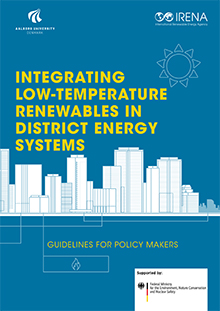Reducing the heating and cooling sector’s emissions is critical to mitigating the effects of climate change and reducing air pollution. District heating and cooling systems can assist in scaling up renewable energy use, decreasing the utilisation of fossil fuels in the heating and cooling sector, and improving urban air quality.

Please click here to view the report (or visit the IRENA website for more information)
District heating systems have been built to run at high temperatures to meet the demands of poorly insulated buildings. In most cases, this necessitates the use of fossil fuels. However, technology innovation, digitalisation and current trends towards more energy-efficient buildings may enable the broader deployment of clean energy technologies – such as low-temperature geothermal, solar thermal, or energy from water bodies or low-temperature waste heat sources – in the new generation of district energy systems. These sources are widely available at the local level in many regions. Still, they remain largely untapped because they are not immediately compatible with current district energy infrastructure and existing building stock.
This guidebook by the International Renewable Energy Agency (IRENA) and Aalborg University (AAU) provides information for policy makers and examples of available tools and solutions to facilitate the use of low-temperature renewable heat sources in new and existing district energy systems. An overview of applications and enabling technologies for district heating and cooling utilising low-temperature renewable energy is also presented.
Key recommendations:
- Develop strategic heating and cooling plans based on clear political drivers and identify key stakeholders to engage in the energy transition.
- Elaborate on technical scenarios based on assessments of demand for heating and cooling, as well as the mapping of locally available low-temperature renewable energy resources.
- Implement the switch from fossil fuels to renewables in conjunction with the modernisation of district energy networks and the renovation of building stock to achieve an optimum performance (both technical and socio‑economic).
- Promote the utilisation of locally available renewable energy sources for heating and cooling by addressing intrinsic challenges.
- Ensure enabling regulatory conditions, supportive financing options and business models are established.